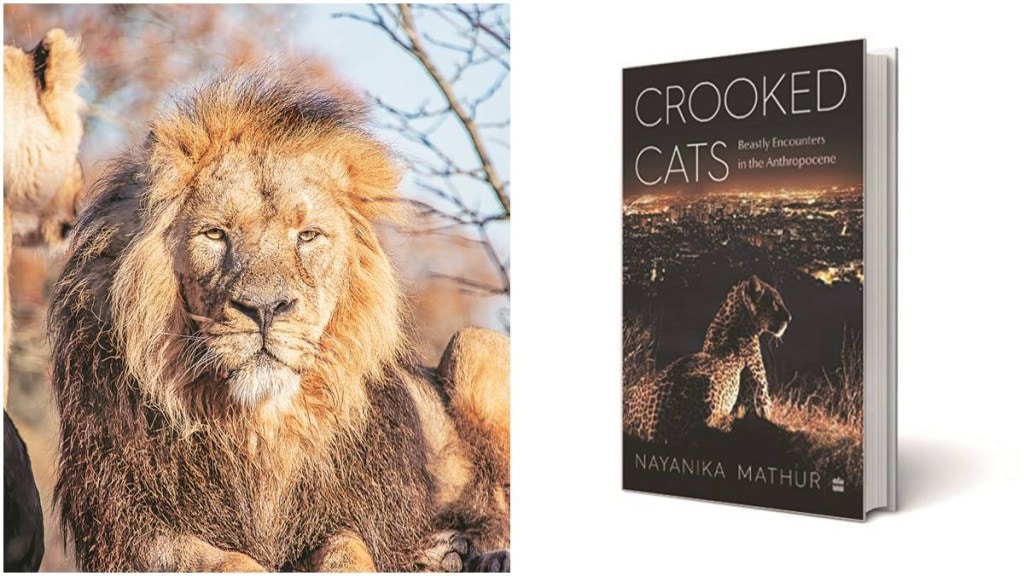By Reena Singh
Who is the real beast in the Anthropocene?” questions Nayanika Mathur as she highlights the interspecies interactions of humans and big cats in her book Crooked Cats: Beastly Encounters in the Himalayas. The book pays attention to climate translations and changing relations between humans and big cats. Dwelling on her 15 years of research, mainly in central Indian Himalaya and Mumbai, Mathur offers narratives on the role of individuals and their conservationist drive or discursive framings, factoring in incidences through which big cats—lions, tigers, leopards—come to be perceived as certain type of creatures and conceptualised as ‘crooked’.
She talks about the changing modalities of visualising the beasts, the unintended side effects of the new leaps in digital conservation, and how the proliferation of new technologies can undermine the wider project of conservation. Clips of leopards that fall into wells or with a pot stuck on its head since he had wandered into a village seeking water, show an overwhelming response of people in favour of protecting the animal and having a sympathetic stance. On the contrary, emerging technologies have also had the powerful impact of generating outrage when videos of pet dogs being mutilated go viral, which lead to demands for hunting, caging and tranquilisation of big cats.
While technology radically alters human-animal interactions, Mathur talks about how animals are powerfully pointing us to the facticity of the climate crisis—“to shape it such that these humble beastly tales can come together to illuminate something as big and apocalyptic as the climate crisis and animals as elusive and endangered as tigers or leopards as well as their relationships with humans”. She describes her stories as a “form of translation between natural and social sciences, empire and post-colonial, the local and global, human and nonhuman and the contemporary, past and future, which are all types of climate translation”. The complex assemblage of things, humans and animals have together brought us to the state of a climate emergency, she writes.
Also Read: The book of probable obituaries: A dark prophecy of global economic crises can be a wake-up call too
Whether it is the lack of fear of humans due to their indigeneity or the desire to seek retribution against humans for their land grabs, poaching and habitat degradation; there are various speculations for why cats become crooked. Mathur argues that India has become a victim of her own successes in tiger conservation. Since tiger numbers have increased substantially from 2006-2018, it has led to greater pressure over the sharing of resources between humans and tigers and subsequently an increase in human-animal conflict. Tigers are thought to prefer dense forests, but recent cases show evidence of tigers and leopards in human-dominated landscapes all over India, which is in the wake of rapid biodiversity depletion and the wanton destruction of habitat. The state, with its policies of management, conservation, regulation, and political interference, is another prominent argument.
Mathur deliberates how the federal nature of governance in India complicates the reliable statistics on the capture and relocation of big cats and their translocation is kept under the radar to escape strict wildlife laws. To avoid electoral backlashes, orders are issued to ensure the safely locking away of leopards and later transporting them to another area. Mathur elaborates on Vidya Athreya’s argument on the correlation between the trapping and relocation of the big cats and their spurt in attacks on humans.
The debate on crooked cats being described as a reign of terror is getting resolved by ethnological understanding that animals are highly intelligent and have subjective, culture lives and are central to the shaping of colonial power. Though the role of modern politics, ecological breakdown and the centrality of human action was a much-needed intervention, the interconnections between crooked cats, Anthropocene and climate change seems repetitive. The book is a good read for those who are interested in human ethnography and climate narratives in the Himalayan borderlands.
(Reena Singh is senior fellow, ICRIER. All views are personal.)








